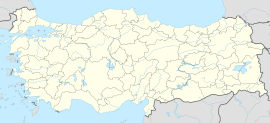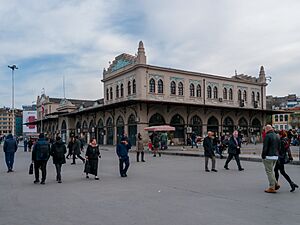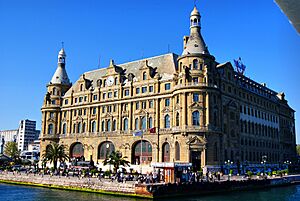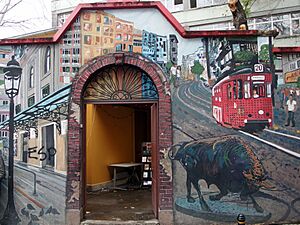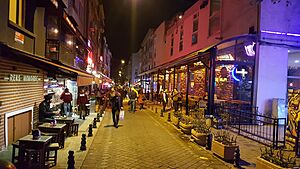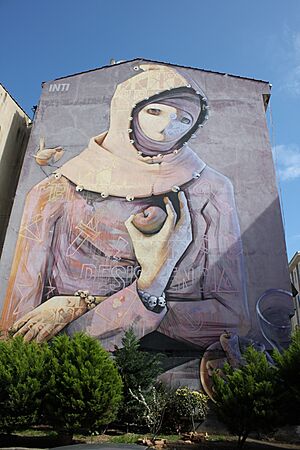Kadıköy facts for kids
Quick facts for kids
Kadıköy
|
|
|---|---|
|
Settlement
|
|
|
Clockwise from top: Haydarpaşa railway station, Nostalgic tram (T3 line), Barış Manço House, Haldun Taner Stage in Kadıköy Square, Süreyya Opera House and Kadıköy bull statue
|
|
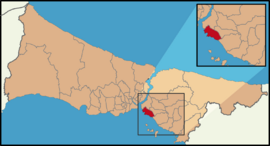
Map showing Kadıköy District in Istanbul Province
|
|
| Country | Turkey |
| Province | Istanbul |
| Area | 25 km2 (10 sq mi) |
| Population
(2023)
|
467,919 |
| • Density | 18,700/km2 (48,500/sq mi) |
| Time zone | TRT (UTC+3) |
| Postal code |
34710
|
| Area code | 0216 |
Kadıköy (pronounced ka-duh-koy) is a lively area in Istanbul, Turkey. It's located on the Asian side of the city, right on the northern shore of the Sea of Marmara. Kadıköy is a large and busy district with a population of over 467,000 people. It covers an area of 25 square kilometers.
This district is known for being a fun and cultural spot. It has many cafes, cinemas, and bookstores. Kadıköy is also home to Bağdat Avenue, one of Turkey's most famous shopping streets. Many important transportation routes that connect different parts of Istanbul pass through Kadıköy.
Kadıköy is considered one of the most expensive places in Istanbul. It's a popular place to live and visit. The district is bordered by Üsküdar to the northwest, Ataşehir to the northeast, and Maltepe to the southeast.
Contents
- What's in a Name? The Meaning of Kadıköy
- A Journey Through Time: The History of Kadıköy
- Exploring Kadıköy Today
- Beyond the Center: Surrounding Areas
- Weather in Kadıköy
- Buildings and Art: Architecture in Kadıköy
- Sports in Kadıköy
- Different Beliefs: Religion in Kadıköy
- Friends Around the World: Twin Towns
- Images for kids
- See also
What's in a Name? The Meaning of Kadıköy
The name Kadıköy has a special meaning. It comes from the Turkish words Kadı (judge) and köy (village). So, Kadıköy literally means 'village of the judge'. This name came about because the area was once managed by the courts of Constantinople.
Long ago, people also thought the name came from the ancient Greek name, Chalcedon.
A Journey Through Time: The History of Kadıköy
Kadıköy is much older than many other parts of Istanbul on the Asian side.
Ancient Beginnings
Scientists have found very old items in Kadıköy, dating back to 5500–3500 BC. These findings show that people have lived here continuously since prehistoric times. There was even a port settlement built by the Phoenicians.
The ancient city of Chalcedon was founded here by Greeks from Megara in 685 BC. This was even before they built Byzantium (which is now Istanbul) across the strait in 667 BC.
The 'City of the Blind'
Chalcedon became known as the 'city of the blind'. The story says that the people of Chalcedon must have been 'blind' not to see the perfect location for a great city on the other side of the Golden Horn. That spot, with its natural harbor, became Byzantium.
An important church meeting, the Council of Chalcedon, was held here in 451 AD.
Changing Hands and Ottoman Rule
Over many centuries, Chalcedon was ruled by different empires, including the Persians, Romans, and Byzantines. It finally became part of the Ottoman Empire in 1353. This was a whole century before the Fall of Constantinople in 1453! Because of this, Kadıköy has Istanbul's oldest mosque, built almost 100 years before the rest of the city was conquered.
When the Ottomans took over, Chalcedon was a quiet, rural area. It soon came under the control of Constantinople's judges, which is how it got the name Kadıköy. During the Ottoman period, Kadıköy grew into a market for farm goods. It also became a place where people lived and traveled by boat to work in the main city.
In 1882, records show that Kadıköy had a mix of people. There were Muslims, Armenians, Greeks, Jews, Latins, Bulgarians, and Catholics living together.
Kadıköy officially became its own district in 1928. Before that, it was part of the Üsküdar district.
Exploring Kadıköy Today
What are the Neighborhoods Like?
Kadıköy District has 21 different neighborhoods. Each one has its own unique feel.
- 19 Mayıs
- Acıbadem
- Bostancı
- Caddebostan
- Caferağa
- Dumlupınar
- Eğitim
- Erenköy
- Fenerbahçe
- Feneryolu
- Fikirtepe
- Göztepe
- Hasanpaşa
- Koşuyolu
- Kozyatağı
- Merdivenköy
- Osmanağa
- Rasimpaşa
- Sahraycıedit
- Suadiye
- Zühtüpaşa
Getting Around: Transport in Kadıköy
Kadıköy is a major transportation hub. It connects people from the Asian side of Istanbul to the European side.
Train Stations
The big Haydarpaşa Terminal is near Kadıköy's center. It opened in 1908 for trains heading to Baghdad and Damascus. It closed for a while but reopened in 2018 for regional and long-distance trains.
Söğütlüçeşme railway station is another important stop. It's where the Metrobus line from the European side ends.
Metro Lines
The M4 metro line runs from Kadıköy to Sabiha Gökçen International Airport. It operates daily from early morning until late at night.
The Marmaray train line also connects Kadıköy, going under the Bosphorus strait.
Trams and Buses
The T3 nostalgic tram is a fun way to see the center of Kadıköy. It goes through Mühürdar, Bahariye, and Moda.
There's a large bus and minibus terminal next to the ferry quay. Many bus lines start here, taking you to different parts of Istanbul.
Ferryboats
Ferries are a very popular way to travel from Kadıköy. You can take traditional ferries to places like Eminönü, Karaköy, Kabataş, Beşiktaş, and the Princes' Islands.
Sea buses also offer faster trips to places like Yenikapı and Bakırköy.
Learning and Growing: Education in Kadıköy
Kadıköy is home to several important universities and high schools.
Marmara University has many buildings here, including the beautiful Haydarpaşa Campus. Doğuş University is another private university located in the Acıbadem neighborhood.
Important high schools include Atatürk Fen Lisesi, Kadıköy Anadolu Lisesi, and Saint-Joseph French High School.

Shopping Fun in Kadıköy
Kadıköy is a very busy place for shopping. You'll find all kinds of shops and different styles of buildings. Some streets are narrow alleys, while others, like Bahariye Caddesi, are just for people walking.
Turkey's biggest food market is here, near the Osman Ağa Mosque. It sells fresh food from all over Turkey, including fish, seafood, and olive oil soap. There are also modern shopping malls, like the large Tepe Nautilus Mall.
You can find many bookstores, craft shops, and music stores. The Akmar Pasajı arcade is famous for selling hard rock and heavy metal music. On Sundays, this area turns into a big outdoor market for used books and music.
At a busy intersection called Altıyol (meaning 'Six Ways'), you'll see a statue of a bull. From here, you can go to the Salı Pazarı (Tuesday Market), a huge street market.
Where to Live: Housing in Kadıköy
The center of Kadıköy has many homes, some older but still charming. It's a popular area for students and people from other countries.
Fun and Food: Attractions, Entertainment, and Eating
Kadıköy is famous for its narrow streets filled with cafes, bars, and restaurants. There are also many cinemas, including the Süreyya Opera House, which used to be a historic movie theater.
The market area has lots of fast-food places selling sandwiches, hamburgers, and döner. You can also find traditional Turkish restaurants and sweet shops. There are places to play backgammon and listen to jazz or rock music.
While Kadıköy might not have the fancy nightlife of some other Istanbul areas, it's known for being lively and cozy. Residents love to walk along the seaside and enjoy the view of the European side of Istanbul.
Beyond the Center: Surrounding Areas
Coastal Neighborhoods
Along the coast, away from the main center, you'll find more expensive shops and upscale neighborhoods. The Moda quarter, south of central Kadıköy, is an old, quiet, and diverse area. It has many historic houses, churches, and well-known schools. Moda is also popular for its modern cafes and shops.
Further along the coast, you'll see the huge Şükrü Saracoğlu Stadium, home to the Fenerbahçe Football Club. From here, the long shopping street Bağdat Avenue stretches east. Many wealthy neighborhoods like Göztepe, Caddebostan, Erenköy, and Suadiye are located between the avenue and the coast. These areas used to have summer houses, but now they have modern apartment buildings. The coast here has beautiful parks and yacht marinas.
Inland Areas
Inland from the coast, there are many housing developments, especially in areas like Kozyatağı. These districts are home to many of Istanbul's upper-middle-class residents. They have wide, tree-lined streets with apartment buildings that often have gardens. Kozyatağı is known for its many green spaces and parks.
Another nice neighborhood is Acıbadem. It has a famous private hospital and a street full of cafes and restaurants. New luxury housing areas like Ataşehir were built north of the main highway. Ataşehir became a separate district in 2009.
Weather in Kadıköy
Kadıköy has a Mediterranean climate. This means it has cool winters and warm to hot summers.
| Climate data for Göztepe, Istanbul | |||||||||||||
|---|---|---|---|---|---|---|---|---|---|---|---|---|---|
| Month | Jan | Feb | Mar | Apr | May | Jun | Jul | Aug | Sep | Oct | Nov | Dec | Year |
| Mean daily maximum °C (°F) | 8.7 (47.7) |
9.3 (48.7) |
11.5 (52.7) |
16.7 (62.1) |
21.4 (70.5) |
26.1 (79.0) |
28.2 (82.8) |
28.1 (82.6) |
25.0 (77.0) |
19.8 (67.6) |
15.4 (59.7) |
11.2 (52.2) |
18.5 (65.2) |
| Daily mean °C (°F) | 5.6 (42.1) |
5.8 (42.4) |
7.5 (45.5) |
11.9 (53.4) |
16.5 (61.7) |
21.1 (70.0) |
23.2 (73.8) |
22.9 (73.2) |
19.7 (67.5) |
15.3 (59.5) |
11.6 (52.9) |
8.1 (46.6) |
14.1 (57.4) |
| Mean daily minimum °C (°F) | 2.9 (37.2) |
3.1 (37.6) |
4.2 (39.6) |
8.0 (46.4) |
12.0 (53.6) |
16.1 (61.0) |
18.4 (65.1) |
18.4 (65.1) |
15.5 (59.9) |
11.9 (53.4) |
8.4 (47.1) |
5.4 (41.7) |
10.4 (50.6) |
| Average precipitation mm (inches) | 87.9 (3.46) |
70.2 (2.76) |
62.5 (2.46) |
43.2 (1.70) |
30.2 (1.19) |
27.0 (1.06) |
23.9 (0.94) |
29.7 (1.17) |
46.7 (1.84) |
69.2 (2.72) |
90.5 (3.56) |
111.5 (4.39) |
692.5 (27.25) |
Buildings and Art: Architecture in Kadıköy
Kadıköy has many old houses from the Ottoman and even Roman times. Some of these hidden gems have been turned into cafes and restaurants. The Yeldeğirmeni neighborhood is especially known for its interesting buildings and street art.
Sports in Kadıköy

Kadıköy is home to the famous Turkish sports club, Fenerbahçe S.K.. Their football stadium, the Şükrü Saracoğlu Stadium, is located here. This stadium even hosted the 2009 UEFA Cup Final.
Kadıköy is also where the first football match in the Ottoman Empire was ever played! When Fenerbahçe wins, the whole district celebrates with cheering crowds.
The Caferağa Sport Hall in Kadıköy's center hosts basketball and volleyball teams.
Different Beliefs: Religion in Kadıköy
Kadıköy has always been a place where people of different faiths live together. You can find mosques, Greek and Armenian Orthodox churches, and Ottoman–Jewish synagogues.
The town is also an important center for the Ecumenical Patriarchate of Constantinople, a major Christian church. The Hemdat Israel Synagogue, near Haydarpaşa Terminal, is one of Istanbul's oldest Jewish places of worship.
Friends Around the World: Twin Towns
Kadıköy is connected with other cities around the world as 'twin towns'. This helps them share culture and ideas.
 Friedrichshain-Kreuzberg (Berlin), Germany
Friedrichshain-Kreuzberg (Berlin), Germany Petah Tikva, Israel
Petah Tikva, Israel
Images for kids
See also
 In Spanish: Distrito de Kadıköy para niños
In Spanish: Distrito de Kadıköy para niños








